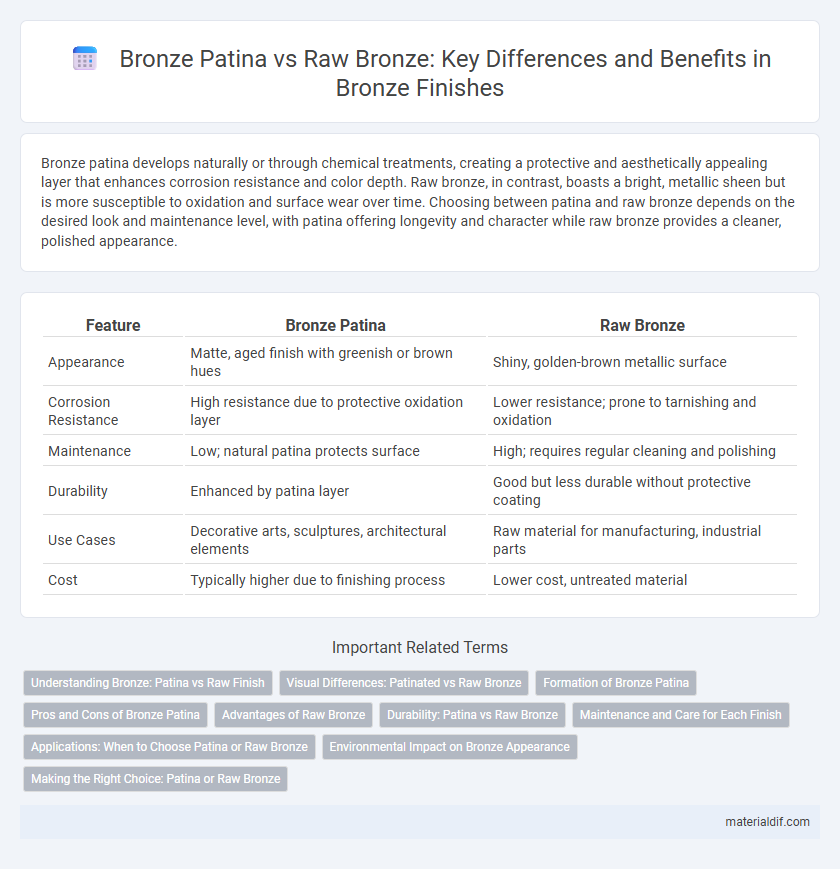Bronze patina develops naturally or through chemical treatments, creating a protective and aesthetically appealing layer that enhances corrosion resistance and color depth. Raw bronze, in contrast, boasts a bright, metallic sheen but is more susceptible to oxidation and surface wear over time. Choosing between patina and raw bronze depends on the desired look and maintenance level, with patina offering longevity and character while raw bronze provides a cleaner, polished appearance.
Table of Comparison
| Feature | Bronze Patina | Raw Bronze |
|---|---|---|
| Appearance | Matte, aged finish with greenish or brown hues | Shiny, golden-brown metallic surface |
| Corrosion Resistance | High resistance due to protective oxidation layer | Lower resistance; prone to tarnishing and oxidation |
| Maintenance | Low; natural patina protects surface | High; requires regular cleaning and polishing |
| Durability | Enhanced by patina layer | Good but less durable without protective coating |
| Use Cases | Decorative arts, sculptures, architectural elements | Raw material for manufacturing, industrial parts |
| Cost | Typically higher due to finishing process | Lower cost, untreated material |
Understanding Bronze: Patina vs Raw Finish
Bronze patina develops naturally or through chemical treatments, creating a protective, aged surface that enhances corrosion resistance and aesthetic depth. Raw bronze presents a bright, reflective finish prone to oxidation, requiring regular maintenance to prevent tarnishing and preserve its metallic luster. Understanding the differences between bronze patina and raw bronze finish is crucial for applications in art, architecture, and industrial design, affecting longevity and visual appeal.
Visual Differences: Patinated vs Raw Bronze
Bronze patina exhibits a rich, varied surface with colors ranging from deep greens and blues to warm browns, creating an aged, textured appearance that enhances the metal's character. Raw bronze displays a bright, shiny, and smooth surface with golden and reddish hues, reflecting its unweathered, polished state. These visual differences highlight patina as a natural protective layer formed through oxidation, contrasting with the clean, untarnished look of raw bronze.
Formation of Bronze Patina
Bronze patina forms through a natural oxidation process where copper in the alloy reacts with moisture, oxygen, and carbon dioxide in the environment, creating a protective layer that varies in color from green to brown. This patina enhances the durability and aesthetic appeal of bronze compared to raw bronze, which remains more prone to corrosion and surface wear. The rate and appearance of patina formation depend on environmental factors such as humidity, pollution, and exposure to chemicals.
Pros and Cons of Bronze Patina
Bronze patina enhances corrosion resistance and adds an aesthetically rich, antique look valued in art and architecture, while raw bronze offers a brighter, more polished finish but is prone to oxidation and tarnishing. The patina serves as a protective layer, reducing the need for frequent maintenance, yet it can obscure fine details and may alter the original bronze color, which might be undesirable for some applications. Opting for bronze patina balances durability and character, beneficial where longevity and visual depth are prioritized over the metal's natural sheen.
Advantages of Raw Bronze
Raw bronze offers superior electrical conductivity and strength compared to bronze patina, making it ideal for industrial applications requiring durability and efficient energy transfer. Its untreated surface resists corrosion longer in non-acidic environments due to the naturally forming oxide layer that protects the metal underneath. Raw bronze also maintains a brighter, more reflective finish, enhancing both aesthetic appeal and visibility in architectural and decorative uses.
Durability: Patina vs Raw Bronze
Bronze patina provides a protective layer that enhances durability by preventing oxidation and corrosion, extending the lifespan of bronze objects. Raw bronze, while naturally resistant to rust, is more susceptible to surface wear and environmental damage without this protective coating. Patinated bronze maintains its structural integrity and aesthetic appeal longer than raw bronze when exposed to outdoor or harsh conditions.
Maintenance and Care for Each Finish
Bronze patina requires gentle cleaning with mild soap and water to preserve its aged surface and prevent damage to the protective oxide layer. Raw bronze benefits from regular waxing and polishing to maintain its natural luster and inhibit oxidation that leads to tarnishing. Both finishes demand careful handling to avoid abrasive materials, ensuring longevity and aesthetic appeal over time.
Applications: When to Choose Patina or Raw Bronze
Bronze patina offers enhanced corrosion resistance and an aged aesthetic, making it ideal for outdoor sculptures, architectural elements, and decorative hardware exposed to weather. Raw bronze, prized for its natural luster and ease of machining, suits applications requiring metallurgical integrity, such as marine fittings, bearings, and precision instruments. Choosing between patina and raw bronze depends on environmental exposure, desired visual appeal, and functional performance requirements.
Environmental Impact on Bronze Appearance
Bronze patina forms naturally over time through oxidation, providing a protective layer that slows further corrosion and reduces maintenance needs. Raw bronze, while initially shiny, is more susceptible to environmental factors such as moisture, pollution, and UV exposure, which can cause rapid tarnishing and deterioration. The environmental impact on bronze appearance emphasizes that patina not only enhances aesthetic character but also extends the metal's longevity by mitigating the effects of weathering and pollutants.
Making the Right Choice: Patina or Raw Bronze
Choosing between bronze patina and raw bronze depends on the desired aesthetic and durability needs; patina offers a protective layer that enhances color variation and resists corrosion, while raw bronze provides a natural, polished look that darkens over time. Patina-treated bronze is ideal for outdoor sculptures and architectural elements due to its weather-resistant properties, whereas raw bronze suits indoor applications where gradual aging is a desired effect. Consider maintenance requirements and environmental exposure when making the decision to ensure longevity and preservation of the bronze's visual appeal.
Bronze Patina vs Raw Bronze Infographic

 materialdif.com
materialdif.com